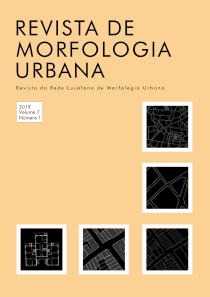Abstract
This research brings an approach on the spatial qualities of the city and its effect on urban sociability from an exploratory case study of a neighborhood of Recife-PE, Brazil. This city has been experiencing a high verticalization and densification of certain areas of the city, the increase of closed interfaces and little diversity of uses of the ground. Thus, we ask: To what extent can spatial configuration influence the types of encounters between individuals that lead to urban sociability? From this, the objective of this research is to identify which morphological and social parameters of a neighborhood would have correlation with a greater urban sociability. For development, the study of the emergence of a social pattern through a questionnaire on urban sociability, based on facet theory, is analyzed and the spatial qualities of the street segment where the interviewees reside are analyzed using the spatial profile methodology. This research intends to reveal how these spatial and social qualities can impact the urban sociability and, in this way, describe those morphological aspects necessary to achieve a good urban quality in the city of Recife.
References
Bulmer, M. (1986) Neighbours: The work of Philip Abrams. Primera ed. Cambridge, Cambridge University Press.
Canter, D. (1983) The purposive Evaluation of Places - A Facet Approach. Environment and Behaviour, 15(6), 659-698.
Cavalcanti, R. (2013) Espaço e crime: Desvendando a lógica dos padrões espaciais de crimes urbanos no bairro de Boa Viagem, Recife-PE. Recife: Dissertação, MDU-UFPE.
Guttman, L. (1957) Introduction of Facet Design and Analysis. Proceedings of the Fifth International Congress of Psychology, Brussels. Amsterdam, North Holland Publishing Co.
Hanson, J. (2000) Urban transformations: a history of design ideas. Urban Design International, 5(2), 97-122.
Hillier, B. e Hanson, J. (1984) The social logic of space. Londres, Cambridge University Press.
Hillier, B. (1989) The Architecture of the urban object. Ekistics, 334/335, 5-21.
Holanda, F. (2002) O espaço de exceção. Brasília, UnB.
Jacques, P., 2008. Corpografias urbanas. Arquitextos, 093.07. Disponível em: http://www.vitruvius.com.br/ revistas/ read/arquitextos/08.093/165 [Acesso em 24 Janeiro 2019].
Legeby, A. (2013) Patterns of co-presence: Spatial configuration and social segregation. Stockholm, School of Architecture. Royal Institute of Technology (PhD Dissertation).
Lopes, A. (2001) Relações de vizinhança no espaço dos apartamentos. Recife (Dissertação, MDU, UFPE): s.n.
Lopes, A. (2008) Condomínios residenciais: Novas faces da sociabilidade e da vivência de transgressões sociais. Recife: Tese, MDU UFPE.
Monteiro, C. (1989) The experience of Place: a comparative analysis of middle class neighborhoods, public housing estates and favela in Brazil. Oxford, University of Oxford.
Monteiro, C. (2010) Spatial Analysis od Street Crimes. Em: Shoham, S. G.; Knepper, P.; Kett, M. (eds.) International Handbook of criminology. s.l.:CRC Press, pp. 619-648.
Monteiro, C. e Cavalcanti, R. (2017) Perfis espaciais urbanos para avaliação de lugares vulneráveis ao crime. Em: Netto, V.M., Saboya, R.T., Vargas, J.C. e Carvalho, T. (eds.) Efeitos da arquitetura: os impactos da urbanização contemporânea no Brasil. Brasília: FRBH Edições, pp. 137-161.
Netto, V. M. (2016) A cidade como resultado. Em: Balbim, R., Krause, C. e Linke, C. (eds.) Cidade e movimento: Mobilidades e Interações no Desenvolvimento Urbano. Brasília, Instituto de Pesquisa Econômica Aplicada - IPEA, pp. 101-130.
Netto, V. M. (2016) The social fabric of cities. London, Routledge.
Netto, V. M., Vargas, J. e Saboya, R. (2012) (Buscando) os efeitos sociais na morfologia arquitetônica. Urbe. Revista Brasileira de Gestão Urbana, jul./dez., 4(2), pp. 261-282.
Olagnero, M., Torrioni, P. e Saraceno, C. (2007) Patterns of sociability in the enlarged EU. Em: Alber, J., Fahey, T. e Saraceno (eds.) Handbook of Quality of Life in the Enlarged European Union. New York, Routledge.
Saboya, R., Netto, V. M. e Vargas, J. (2015) Fatores morfológicos da vitalidade urbana: uma investigação sobre o tipo arquitetônico e seus efeitos. Arquitextos, 180.2. Disponível em http://vitruvius.com.br/revistas/read/ arquitextos/15.180/5554 [Acesso em 07 Agosto 2019].
Os direitos autorais permanecem com os autores, que autorizam a Revista de Morfologia Urbana a publicar o artigo sob uma licença Creative Commons Atribuição (CC-By).


